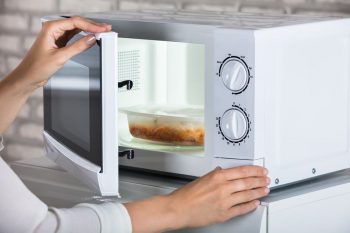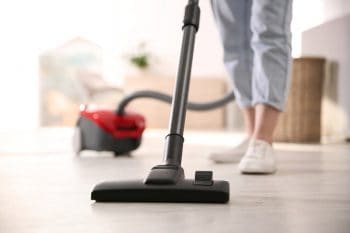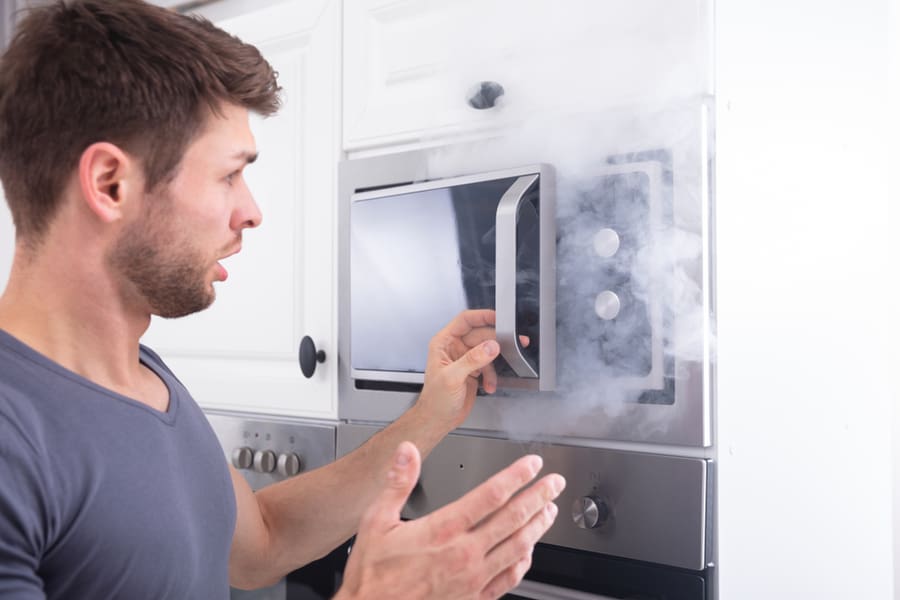
A microwave provides a quick and uncomplicated way of cooking certain food, but if you do not take of it, malfunctioning can occur.
Several microwave users face sparking and smoking, which occurs when you incorrectly use the appliance. If you experience such a problem, use the three tips below to solve it.
Sparking or smoking is an alarming issue that many microwave users experience. However, it would be best if you did not dispose of it due to that problem because you can fix it.
Higher levels of electricity used by microwaves make them susceptible to sparking or smoking problems.
The major causes of microwave sparking or smoking are issues with waveguide cover or metal fragments in the Microwave. Both issues are easy to fix.
Another cause of sparking or smoking problems are faulty diode. Again, you can fix the problem, but you must seek help from a trained microwave technician to repair your Microwave.
Since Microwave uses high currents and voltage, it is vital to be cautious when repairing them. In addition, microwave capacitor stores lethal electricity for several months even after disconnecting it from power.
Therefore, you should discharge the capacitor before you repair any electrical microwave component, such as a magnetron or diode.
The seven common causes of microwave spring or smoking are:
- Damaged or dirty waveguide cover
- Worn microwave racks
- Faulty diode
- Failing magnetron
- Metal in the Microwave
- Overcooking food
- Faulty stirrer
Is a Sparking or Smoking Microwave Dangerous?
Mostly when a microwave starts sparking or smoking is perfectly safe for you. However, turn off your Microwave immediately if you see sparks or smoke because sparks because it will destroy its inside permanently.
Sparking or smoking a microwave is not dangerous to you, but it is to itself. However, it is dangerous to you if sparking or smoking is due to broken electronics. This can lead to electrocution risk.
When unsure if the Microwave is safe, you should unplug it to avoid dangers and find out the problem and solve it.
7 Causes of Microwave Sparking or Smoking
These causes include:
1. Damaged or Dirty Waveguide Cover

If you use your Microwave often, you can experience sparking or smoking due to the waveguide cover. The panel transfers power from the magnetron and distributes the energy that cooks or heats your food.
If you do not clean your microwave, grease and food particles on the waveguide can make your microwave spark or smoke. The smoking or sparking is due to the magnetron burning the food particles that stick to the waveguide.
Frequent sparking and smoking can damage the waveguide cover. In addition, if the Microwave stops heating the food properly, it suggests the waveguide panel is faulty.
The waveguide is irreparable when damaged, and this will force you to buy a new microwave.
For the following steps to fix the waveguide cover problem:
- Ensure the waveguide cover is always clean.
- Check if the waveguide panel has any damage.
- Disconnect your Microwave from power before replacing the faulty waveguide cover.
- Remove the screw from the waveguide cover.
- Wash the area.
- Fix the new waveguide cover.
2. Worn Microwave Racks
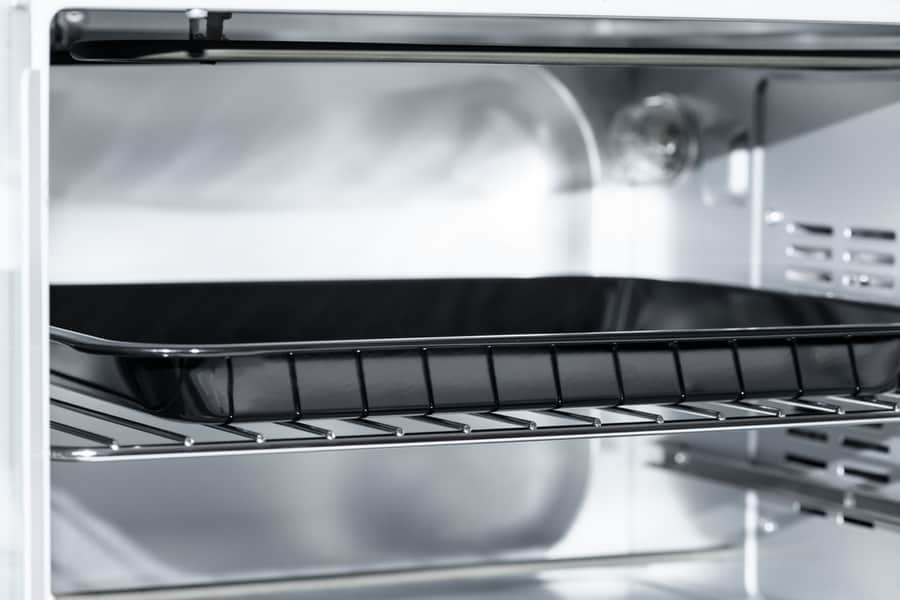
If your Microwave has racks, they could be the reason for sparking or smoking. Microwave racks have metal covered with protective plastic to ensure no sparks or smoke forms on your appliance.
Using the same racks for a long duration may cause the protective plastic cover to wear off or get chipped. To check if your microwave racks are worn off, you can:
- Check if your microwave racks have any exposed metal.
- Replace them if they are to prevent the problem.
3. Faulty Diode
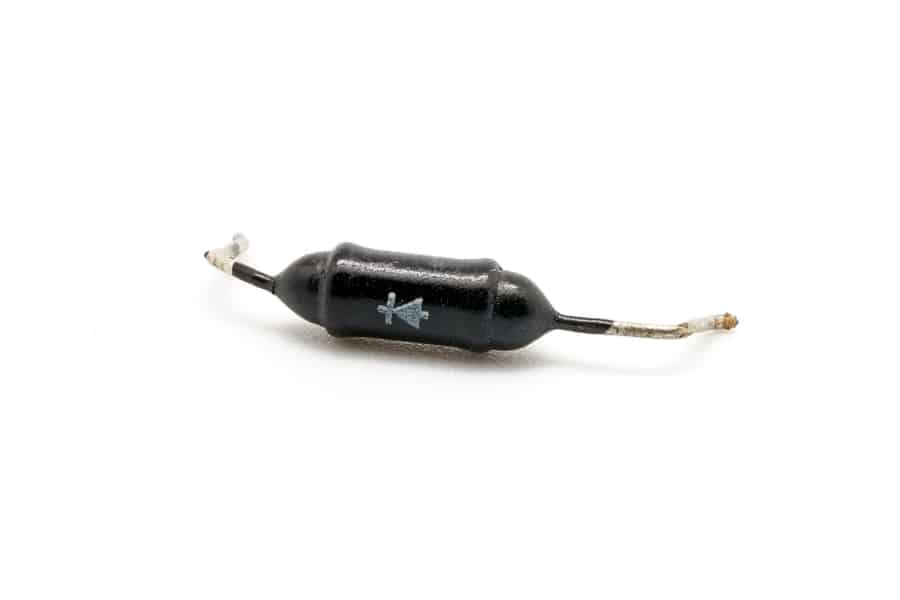
Microwave diode provides a high voltage that powers the magnetron that heats the food. If your Microwave starts sparking or smoking and no longer cooks your food properly, it may be due to a malfunctioning diode.
A burning smell is also a sign of a faulty diode. Microwave diode can wear out, short, or split into two. It is located in the cabinet near the magnetron.
Whenever you want to check if the diode is faulty, ensure you disconnect your Microwave from the power source. Then remove the screws from the Microwave to easily access the panel at the back or on the top.
It would be best to discharge the capacitor though it may contain a lethal amount of electricity even when not connected to the power source.
Use a multimeter to test the diode. The black lead should be held on one end of the diode, and the other end of the diode should be connected to the 9-volt battery on the negative terminal. The red lead should be connected to the positive terminal on the battery.
The diode should have connectivity on direction only. If there is no continuity on the multimeter, reverse the diode such that the black lead is connected to the opposite end of the diode. The battery should be connected from the other side of the diode.
Suppose there is continuity from all directions or negative continuity from all sides when you reverse the leads. That indicates that the diode needs replacement because it is faulty.
4. Failing Magnetron
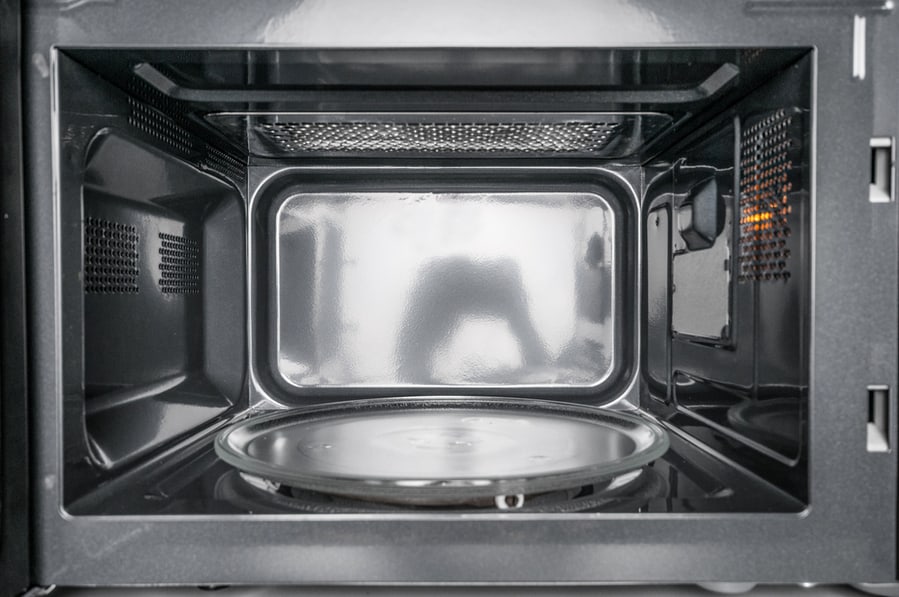
Microwave magnetron rarely causes sparking or smoking problems. However, magnetrons can easily make your microwave spark or smoke when they wear out.
The magnetron creates microwave frequencies that heat your food. If the food does not heat properly and the Microwave’s hum increases when cooking, that is a sign the magnetron is failing. Depending on the microwaves, magnetron’s spars can be seen on the inside.
Take the following precautions when checking the magnetron:
- Turn the Microwave’s power off.
- Remove the Microwave’s top cover to access the magnetron.
- Discharge the capacitor, but it may have a lethal amount of electricity even after disconnecting the power.
- Unscrew it and remove it to access the magnetron easily.
- Test the magnetron using a multimeter.
- Ensure the multimeter is set to the ohms settings.
- Connect the red multimeter lead to one magnetron connector and the black lead to other magnetron connectors.
- The magnetron electric filament works properly if the readings are below one ohm.
- Ensure the multimeter is set to the highest resistance testing setting.
- Put one lead against the magnetron’s metal casing.
- Place the other lead on the other magnetron connectors.
- A core citing working magnetron should read “Open Line” or “OL” on the multimeter.
- You should buy a new magnetron if it is faulty and replace it.
5. Metal in the Microwave
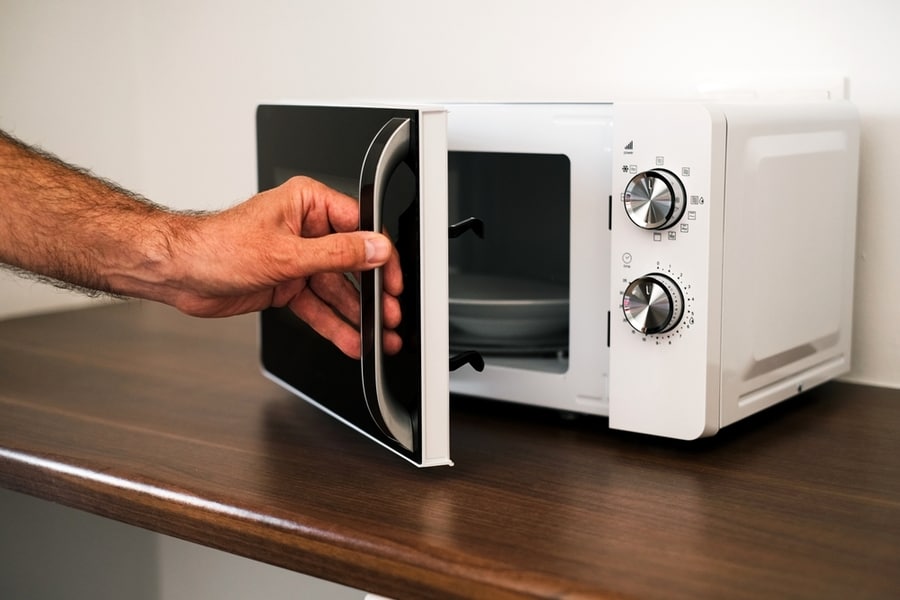
Never put metal or tin foil in your Microwave because it can cause sparks or smoke and eventually damage it. Ensure you clean your metal after use to eliminate metal fragments and other materials that can lead to this problem.
6. Overcooking the Food

The Microwave cooks faster than an oven, so you should be extremely cautious when using it to heat food.
Leaving food to cook for too long can result in smoking, sparks, or fire. You need to know your Microwave’s power and wattage level to prevent overheating.
The user manual contains all the information you need, and if you lost it, you could check for the label that lists the appliance’s power and wattage details.
Also, do not leave your Microwave unattended when in use—standing next to your appliance when heating food allows you to handle any problem that pops up before it gets extreme.
7. Faulty Stirrer
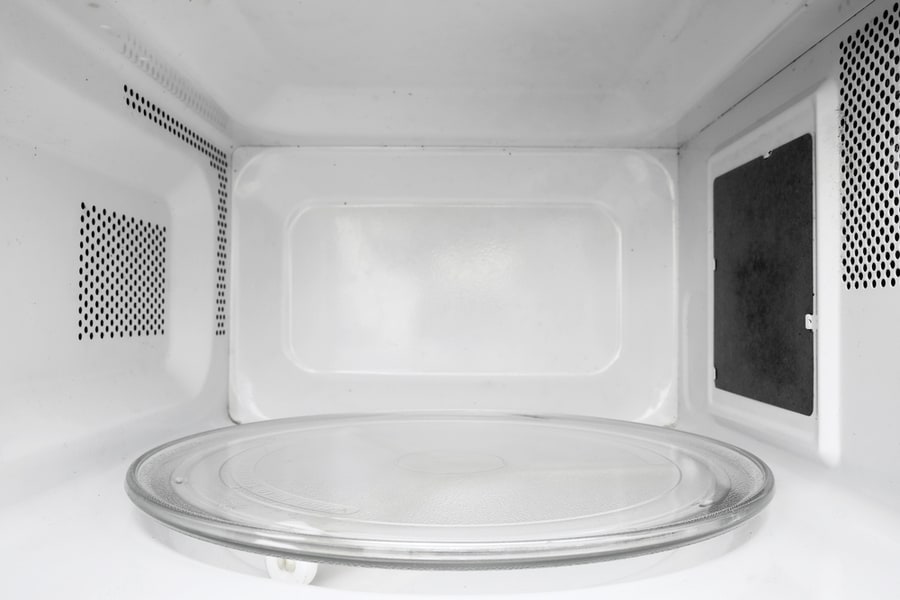
The stirrer helps in heating all the food evenly inside the Microwave. If the stirrer is faulty, it will concentrate the energy on one part, leading to smoking, sparking, or even burning.
The two main reasons that cause the stirrer to stop functioning properly are the broken drive motor and the broken stirrer belt.
To fix this problem, you should disconnect the power from your appliance to check which part is causing the problem. Remove the outer cabinet. Check if anything is blocking the stirrer movement.
It is easy to test drive motors because most microwaves nowadays have a turntable. If the drive motor is faulty, the table cannot turn, and the Microwave cannot work properly.
If the belt is well installed, inspect the belt to see if there are signs of fraying, burning, cracking, or other damages. If there is any damage to the stirrer belt, consider replacing it.
If you cannot do this repair, seek help from an appliance technician or take it to any appliance repair shop near you.
How To Stop Microwave Sparking or Smoking
You should find out the cause of the problem first. The following are the four steps for stopping a sparking or smoking microwave:
- Switch off the Microwave immediately as soon as it starts sparking or smoking. Do not risk electrocution. If the sparks are very bright or coming from the inside, unplug the Microwave to turn it off.
- Check to see if there is any metal inside the Microwave. If you find any, remove it, and your Microwave will be safe.
- If you do not see any metal, check the waveguide cover. Replace it if it has a crack or is damaged.
- The diode could be faulty if you do not find any metal inside, and the waveguide is fine. In such a case, you should unplug the Microwave and look for a professional to repair it. Else buy a new appliance and recycle the old Microwave.
Materials That Cause Sparking or Smoking
You should always use microwave-safe materials to protect your Microwave from sparking or smoking. In addition, certain substances are guaranteed to cause sparking or smoking. Therefore, it is essential to avoid them.
Such materials include:
1. Tin Foil

The foil used to wrap food can cause sparks or smoke in your Microwave. So, before putting your food in the Microwave, ensure you unwrap it.
2. Metal Forks

Thin metal tines can cause sparks, smoke, and arcing electricity. Spoons can also cause the same problem. Do not place any cutlery inside your Microwave.
3. Poptart Wrappers

The foil used to wrap breakfast instant pastries acts like forks in the Microwave. Ensure you unwrap them before putting them in the Microwave.
4. Steel Wool
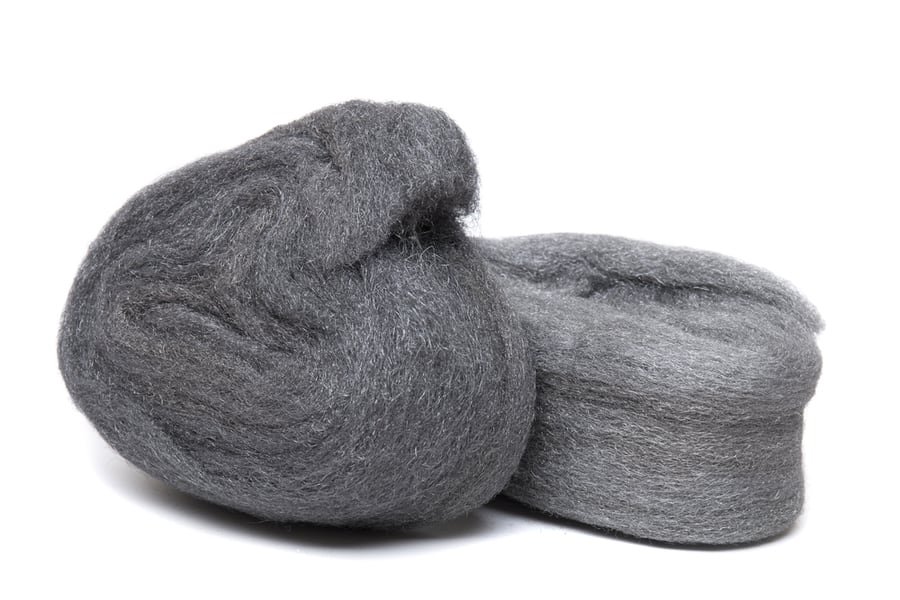
The same reason that causes tin foil and forks cause sparking or smoke in your Microwave makes steel wool results in the same problems. However, steel wool is worse because it is flammable, and the problems can be much bigger.
Do not use steel wool to clean your Microwave. If possible, use something different.
5. Grapes

Although grapes are always in small sizes, they contain water which leads to a hotspot reaction in the Microwave. Cutting the grapes into two pieces and leaving them connected, they form plasma between them.
Do not do this if you want your appliance to continue serving you and your entire family.
Conclusion
If you have been using your Microwave frequently, then sparks and smoke are not new to you. However, if you encounter it for the first time, do not panic; instead, disconnect your Microwave from the power source to examine the exact cause of the problem.
The are various reasons that make a microwave spark or smoke. They are easy to fix, but some may require you to seek help from a professional appliance technician.
Some causes of sparking or smoking may require simple fixing, but some may force you to replace some parts of the appliance or buy a whole new microwave.
Do not decide what step to take without the help of a technician because you may think the Microwave is beyond repair, but you only need to replace one component, and the appliance starts to function properly.
Sparking or smoking a microwave is not dangerous unless it is arcing electricity which can result in electrocution. Once you fix what was causing your Microwave to spark or smoke, you can continue to use it because it is safe and poses no danger.
Frequently Asked Questions
Is It Safe To Use a Microwave After Sparking or Smoking?
Yes, you can continue using your Microwave after sparking or smoking. The cause of the problem is easy to fix. Once you repair the Microwave, you can continue to use it.
Does Radiation Leakage Cause Sparks or Smoking?
No. Radiation leakage cannot cause sparking or smoking. However, a faulty or old door seal can make your Microwave start leaking ration.
Always use a damp towel to wipe your Microwave after use to prevent this problem. Crusty food will never accumulate in the door gasket.



